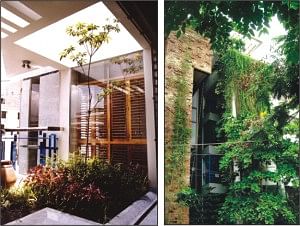Rafiq's enterprising architecture

Designs by Shatotto
Rafiq Azam, who has received 16 national and international awards for architecture and six for paintings held a presentation with accompanying lecture at Bengal Gallery recently. Azam, who is the main architect for Shatotto, that aims for green living, has been teaching for 12 years as a visiting faculty, at universities -- BRAC, Asia Pacific, Ahsanaullah and others -- concentrating on the preservation of Old Dhaka from the outset.
Azam's latest feathers in the cap are the AR Award for Emerging Architecture 2007 (UK), and Berger Award for Excellence, The Kenneth F. Brown, Asia Pacific Culture and Architecture Design (USA), and the South Asia Architecture Commendation Award 2005. This year Azam will be teaching at The National University of Singapore.
Azam, the team leader of Shatotto, won the “Commended Award” from RIBA (Royal Institute of British Architects), competing with 50 countries the world over. Says Azam, speaking to The Daily Star, that their work has to be environment friendly, with lowest level of power consumption, with sustainability, keeping in mind that the home or house is for people living in Dhaka -- a city with a high density of population where the greenery has been radically decimated and the climatic composition of moisture and air has changed drastically over the last two decades.
The six seasons of Bangladesh are also kept in mind. The designers are also very aware that Bangladeshis are not economically that well off, Azam continues. The home, in particular, that won the prize, is an apartment building. “This is like a shoebox, in Gulshan, in which the not so well-off can live in relative comfort. Nine families live in it currently. The top floor has two apartments, and the ambiance is like a cozy home,” says Azam. The house also features a water fountain; the sound of constant gently falling raindrops has a soothing effect, he says.
During summer, the sun is not overhead for the residents, and during winter, in the south the sunrays come with the incline. The breeze passes through the house in summer, as the Bay of Bengal is in the south. Consequently there has been no need of even a ceiling fan in the common areas for the last seven years. The building is of red bricks and gray concrete with no plaster of paints. Moreover, there are shrubs, bamboo-hedges, creepers and flower plants in every nook and corner. It is indeed a veritable paradise on earth, and a crème de la crème existence for the middle-class.

 For all latest news, follow The Daily Star's Google News channel.
For all latest news, follow The Daily Star's Google News channel. 



Comments